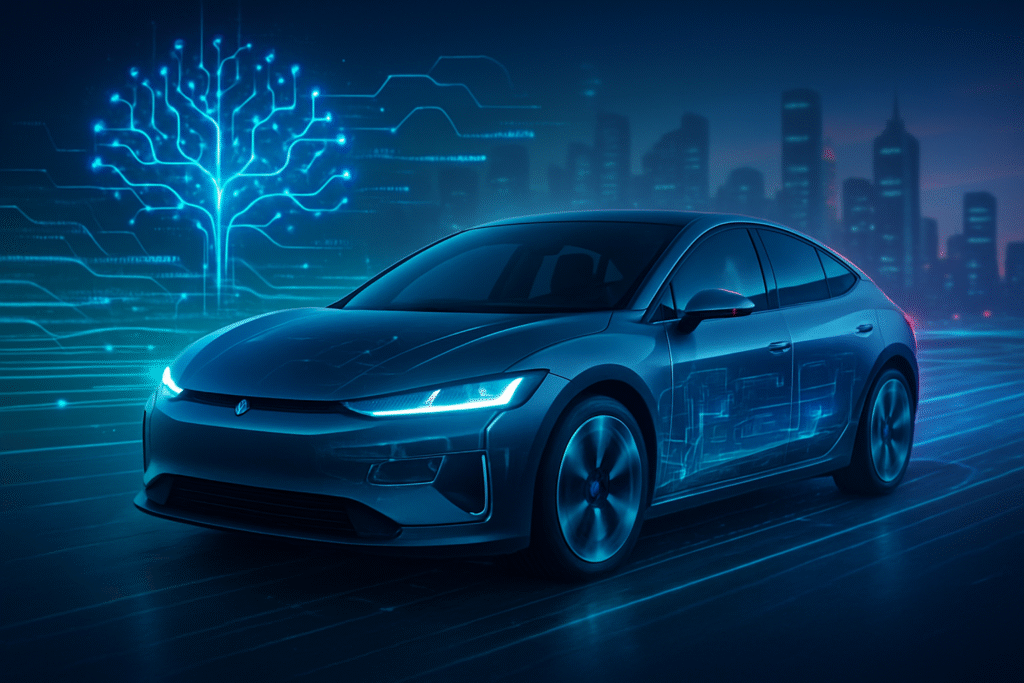Financial News
The Silicon Revolution on Wheels: Advanced Chips Powering the Automotive Future

The automotive industry is in the midst of a profound transformation, driven by an unprecedented surge in demand for advanced semiconductors. As of October 2025, the automotive semiconductor market is experiencing robust growth, projected to reach over $50 billion this year, and poised to double by 2034. This expansion is not merely incremental; it signifies a fundamental redefinition of the vehicle, evolving from a mechanical conveyance to a sophisticated, AI-driven computing platform. The immediate significance of these advanced chips cannot be overstated, as they are the foundational technology enabling the widespread adoption of electric vehicles (EVs), autonomous driving systems, and hyper-connected car technologies.
This silicon revolution is fueled by several converging trends. The relentless push towards electrification, with global EV sales expected to constitute over 25% of all new vehicle sales in 2025, necessitates high-performance power semiconductors. Concurrently, the rapid progression of autonomous driving from assisted features to increasingly self-reliant systems demands powerful AI accelerators and real-time data processing capabilities. Furthermore, the vision of connected cars, seamlessly integrated into a broader digital ecosystem, relies on advanced communication chips. These chips are not just components; they are the "eyes, ears, and brains" of the next generation of vehicles, transforming them into mobile data centers that promise enhanced safety, efficiency, and an entirely new level of user experience.
The Technical Core: Unpacking the Advanced Automotive Semiconductor
The technical advancements within the automotive semiconductor space are multifaceted and critical to the industry's evolution. At the heart of this transformation are several key technological shifts. Wide-bandgap semiconductors, such as silicon carbide (SiC) and gallium nitride (GaN), are becoming indispensable for EVs. These materials offer superior efficiency and thermal management compared to traditional silicon, leading to extended EV ranges, faster charging times, and higher power densities. They are projected to account for over 25% of the automotive power semiconductor market by 2030, with the EV semiconductor devices market alone poised for a 30% CAGR from 2025 to 2030.
For autonomous driving, the complexity escalates significantly. Level 3 autonomous vehicles, a growing segment, require over 1,000 semiconductors for sensing, high-performance computing (HPC), Advanced Driver-Assistance Systems (ADAS), and electronic control units. This necessitates a sophisticated ecosystem of high-performance processors and AI accelerators capable of processing vast amounts of sensor data from LiDAR, radar, and cameras in real-time. These AI-powered chips execute machine learning algorithms for object detection, path planning, and decision-making, driving a projected 20% CAGR for AI chips in automotive applications. The shift towards Software-Defined Vehicles (SDVs) further emphasizes the need for advanced semiconductors to facilitate over-the-air (OTA) updates, real-time data processing, and enhanced functionalities, effectively turning cars into sophisticated computing platforms.
Beyond power and processing, connectivity is another crucial technical domain. Chips equipped with 5G capabilities are becoming essential for Vehicle-to-Everything (V2X) communication. This technology enables cars to share data with each other and with infrastructure, enhancing safety, optimizing traffic flow, and enriching infotainment systems. The adoption of 5G chipsets in the automotive sector is expected to surpass 4G, with revenues nearing $900 million by 2025. Initial reactions from the AI research community and industry experts highlight the critical role of these specialized chips in unlocking the full potential of AI within the automotive context, emphasizing the need for robust, reliable, and energy-efficient solutions to handle the unique demands of real-world driving scenarios.
Competitive Landscape and Strategic Implications
The burgeoning automotive semiconductor market is creating significant opportunities and competitive shifts across the tech industry. Established semiconductor giants like NVIDIA (NASDAQ: NVDA), Intel (NASDAQ: INTC), and Qualcomm (NASDAQ: QCOM) are heavily invested, leveraging their expertise in high-performance computing and AI to develop specialized automotive platforms. NVIDIA, with its Drive platform, and Intel, through its Mobileye subsidiary, are strong contenders in the autonomous driving chip space, offering comprehensive solutions that span sensing, perception, and decision-making. Qualcomm is making significant inroads with its Snapdragon Digital Chassis, focusing on connected car experiences, infotainment, and advanced driver assistance.
However, the landscape is not solely dominated by traditional chipmakers. Automotive original equipment manufacturers (OEMs) are increasingly looking to develop their own in-house semiconductor capabilities or forge deeper strategic partnerships with chip suppliers to gain greater control over their technology stack and differentiate their offerings. This trend is particularly evident in China, where the government is actively promoting semiconductor self-reliance, with a goal for automakers to achieve 100% self-developed chips by 2027. This vertical integration or close collaboration can disrupt existing supply chains and create new competitive dynamics.
Startups specializing in specific areas like neuromorphic computing or novel sensor technologies also stand to benefit. These smaller, agile companies can offer innovative solutions that address niche requirements or push the boundaries of current capabilities. The competitive implications extend to traditional automotive suppliers as well, who must adapt their portfolios to include more software-defined and semiconductor-intensive solutions. The ability to integrate advanced chips seamlessly, develop robust software stacks, and ensure long-term updateability will be crucial for market positioning and strategic advantage in this rapidly evolving sector.
Broader Significance and Societal Impact
The rise of advanced semiconductors in the automotive industry is more than a technological upgrade; it represents a significant milestone in the broader AI landscape, fitting squarely into the trend of pervasive AI. As AI capabilities move from data centers to edge devices, vehicles are becoming one of the most complex and data-intensive edge environments. This development underscores the maturation of AI, demonstrating its ability to operate in safety-critical, real-time applications. The impacts are far-reaching, promising a future of safer roads through enhanced ADAS features that can significantly reduce accidents, more efficient transportation systems through optimized traffic flow and reduced congestion, and a reduced environmental footprint through the widespread adoption of energy-efficient EVs.
However, this technological leap also brings potential concerns. The increasing complexity of automotive software and hardware raises questions about cybersecurity vulnerabilities. A connected, AI-driven vehicle presents a larger attack surface, necessitating robust security measures to prevent malicious interference or data breaches. Ethical considerations surrounding autonomous decision-making in accident scenarios also continue to be a subject of intense debate and require careful regulatory frameworks. Furthermore, the reliance on a global semiconductor supply chain highlights geopolitical sensitivities and the need for greater resilience and diversification.
Compared to previous AI milestones, such as the breakthroughs in natural language processing or image recognition, the integration of AI into automobiles represents a tangible and immediate impact on daily life for millions. It signifies a move from theoretical capabilities to practical, real-world applications that directly influence safety, convenience, and environmental sustainability. This shift demands a holistic approach, encompassing not just technological innovation but also robust regulatory frameworks, ethical guidelines, and a strong focus on cybersecurity to unlock the full potential of this transformative technology.
The Road Ahead: Future Developments and Challenges
The trajectory of the automotive semiconductor market points towards several exciting near-term and long-term developments. In the near future, we can expect continued advancements in specialized AI accelerators tailored for automotive workloads, offering even greater processing power with enhanced energy efficiency. The development of more robust chiplet communication protocols will enable modular, tailored systems, allowing automakers to customize their semiconductor solutions with greater flexibility. Furthermore, innovations in materials beyond traditional silicon, such as two-dimensional materials, alongside continued progress in GaN and SiC, will be critical for delivering superior performance, efficiency, and thermal management in advanced chips.
Looking further ahead, the horizon includes the widespread adoption of neuromorphic chips, mimicking brain behavior for more efficient and intelligent processing, particularly for complex AI tasks like perception and decision-making. The integration of quantum computing principles, while still in its nascent stages, could eventually revolutionize data processing capabilities within vehicles, enabling unprecedented levels of autonomy and intelligence. Potential applications and use cases on the horizon include fully autonomous robotaxis operating at scale, personalized in-car experiences powered by highly adaptive AI, and vehicles that seamlessly integrate into smart city infrastructures, optimizing energy consumption and traffic flow.
However, significant challenges remain. The development of universally accepted safety standards and robust validation methodologies for autonomous systems is paramount. The immense cost associated with developing and manufacturing these advanced chips, coupled with the need for continuous software updates and hardware upgrades, presents an economic challenge for both consumers and manufacturers. Furthermore, the global shortage of skilled engineers and developers in both AI and automotive domains could hinder progress. Experts predict that overcoming these challenges will require unprecedented collaboration between semiconductor companies, automakers, governments, and academic institutions, fostering an ecosystem that prioritizes innovation, safety, and responsible deployment.
A New Era of Automotive Intelligence
In summary, the growth of the automotive semiconductor market represents a pivotal moment in the history of both the automotive and AI industries. Advanced chips are not just enabling the next generation of vehicles; they are fundamentally redefining what a vehicle is and what it can do. The key takeaways from this revolution include the indispensable role of wide-bandgap semiconductors for EVs, the critical need for powerful AI accelerators in autonomous driving, and the transformative potential of 5G connectivity for the connected car ecosystem. This development signifies a significant step forward in AI's journey from theoretical potential to real-world impact, making vehicles safer, smarter, and more sustainable.
The significance of this development in AI history cannot be overstated. It marks a period where AI is moving beyond niche applications and becoming deeply embedded in critical infrastructure, directly influencing human mobility and safety. The challenges, though substantial, are being met with intense innovation and collaboration across industries. As we look to the coming weeks and months, it will be crucial to watch for further advancements in chip architectures, the rollout of more sophisticated autonomous driving features, and the continued evolution of regulatory frameworks that will shape the future of intelligent transportation. The silicon revolution on wheels is not just a technological trend; it is a fundamental shift that promises to reshape our world.
This content is intended for informational purposes only and represents analysis of current AI developments.
TokenRing AI delivers enterprise-grade solutions for multi-agent AI workflow orchestration, AI-powered development tools, and seamless remote collaboration platforms.
For more information, visit https://www.tokenring.ai/.
More News
View More




Recent Quotes
View More
Quotes delayed at least 20 minutes.
By accessing this page, you agree to the Privacy Policy and Terms Of Service.



